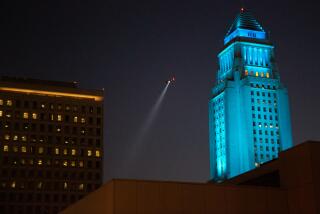Calabasas Copter Firm Is a Model of Success
Aviation engineer John Gorham has had a model career.
He designed the control systems that steer hundreds of civil and military aircraft now flying in Europe. He helped concoct the lift-control and autopilot devices used in the Lockheed L-1011. He studied bad-weather flying landing requirements and airspace problems for the federal government.
But that’s not the model part.
That began six years ago, when Gorham took up the hobby of building radio-controlled helicopters.
He became so enthusiastic about his models that he formed a family business, Gorham Model Products, to turn out model-helicopter kits for other hobbyists. Since then, his fledgling Calabasas company has taken off more like a rocket than a helicopter.
It has turned into the country’s largest maker of flying toy helicopters. And it is turning out the world’s largest scale models of helicopters.
Gunship Look-Alike
Gorham’s latest model is no toy, however. It is a 16-foot-long, 150-pound radio-controlled model that has captured the fancy of the U.S. Army.
The huge model comes with a plastic covering that makes it look like a one-fifth scale version of the Soviet Union’s Mi-24 HIND-D gunship.
The real Soviet craft is said to be a heavily armed, exceedingly maneuverable helicopter capable of flying in zigzag patterns and sneaking up on targets. It reportedly can pop up from behind hills to spray a barrage of rocket fire.
Because radio-controlled model helicopters can be flown in the same dart-about-the-skies fashion, the Army is considering buying about 5,000 of his models, Gorham said. The fully automated drones would be used by the Army and NATO allies for target recognition and evasion training, he said.
Gorham was commissioned to build the first 12 helicopter drones after prototype flight tests last year at Ft. Bliss, Tex., Army base. He plans to team up with a Canadian division of Boeing Co. to bid this spring on a production contract for the rest.
Gunnery Practice
Helicopter drones are commonly used for target practice, said Col. Dave Stewart, an Army spokesman at Ft. Bliss. He said such drones are usually nothing more than metal frames and motors that do not resemble any specific enemy aircraft.
“There’s a lot more to do with this size helicopter,” said Gorham, 63, who lives in Reseda. “They can be made easier to fly fully automated with computers. There are a lot of non-military uses for them.”
Those include turning them into remote-controlled camera platforms for police, broadcasters or real estate agents. They could also be used in industry for inspection of areas contaminated with radioactivity, Gorham said.
“You could fly it in and then blow it up instead of trying to decontaminate it,” he said.
Gorham figures that his new giant-sized helicopter--which has a 10-foot main rotor and can lift 55 pounds--will sell for $15,000 to $20,000 each. In contrast, the smaller hobby helicopter kits his company produces cost between $260 and $1,500, depending on the size and exterior finish of the helicopter.
Venture Formed in 1979
About 23,000 of the flying models have been sold since British-born Gorham and his wife, Louise, formed the company in 1979, the couple said. They grossed $100,000 the first year and logged an estimated $2.2 million in sales in 1985, Gorham said.
Formation of the company was a fluke.
“I led one of the design teams for the L-1011 and had 800 engineers working for me at Lockheed at the peak,” Gorham said. “But after the 1011, I ran out of challenge. I didn’t want to live out the rest of my life at Lockheed.”
Gorham left Lockheed and was working as a private aeronautical consultant when he took up the model helicopter hobby. He said he started his company after encountering difficulty finding model parts.
Gorham Model Products has 22 employees, who package the helicopter kits at the headquarters. Subcontractors make the parts, except in the case of a pre-assembled model made by a Japanese company. The kits and pre-assembled models are sold through hobby shops and by mail.
A long-established German remote-control helicopter maker and two Japanese hobby firms are Gorham’s main competitors.
Because of the complexity of assemblying his 300-piece kits and then flying them, Gorham keeps technicians on telephone duty in Calabasas and at a Pennsylvania office to field technical questions from dealers and hobbyists.
He also keeps his son, Robert, on the road in a motor home demonstrating the flying models.
‘I Fell in Love With It’
“I played with gliders when I was 12 or 13, but then I got interested in girls and motorcycles,” said Robert Gorham, 23, of Thousand Oaks. “I came into the office one day a few years ago and he let me fly one of his helicopters and I fell in love with it.”
Three months ago, young Gorham beat 100 other model fliers to win first place in a national remote-controlled helicopter flying contest in Springfield, Mass. He flew a 4 1/2-foot-long scale-model Cobra Ranger helicopter.
Using a hand-held transmitter that controls altitude, direction and speed, the younger Gorham can duplicate flight patterns of real helicopters. He can also perform tricks such as upside-down hovering that is impossible with pilot-carrying helicopters.
In flight, the small helicopters so closely resemble the real thing that they are occasionally filmed for movie and television helicopter chase and battle scenes.
Chief Test Pilot
Because of his flying skill, the younger Gorham has become the company’s chief test pilot. He puts new versions of helicopters through their paces on a grassy greenbelt next to Parkway Calabasas, a few hundred yards south of Gorham Model Products’ small industrial-park headquarters.
The greenbelt is a few hundred yards north of the Lockheed Corp. headquarters under construction in Calabasas Park.
Gorham said his small family business will share more than a Calabasas headquarters location with huge Lockheed.
“We have the same design problems and the constraints of schedule, performance and cost. Our engineering is no less difficult--it’s just in miniature,” he said.
“It’s just that I have to make a part for 85 cents--not for $850--to compete in the ‘toy market.’ ”
More to Read
Inside the business of entertainment
The Wide Shot brings you news, analysis and insights on everything from streaming wars to production — and what it all means for the future.
You may occasionally receive promotional content from the Los Angeles Times.











